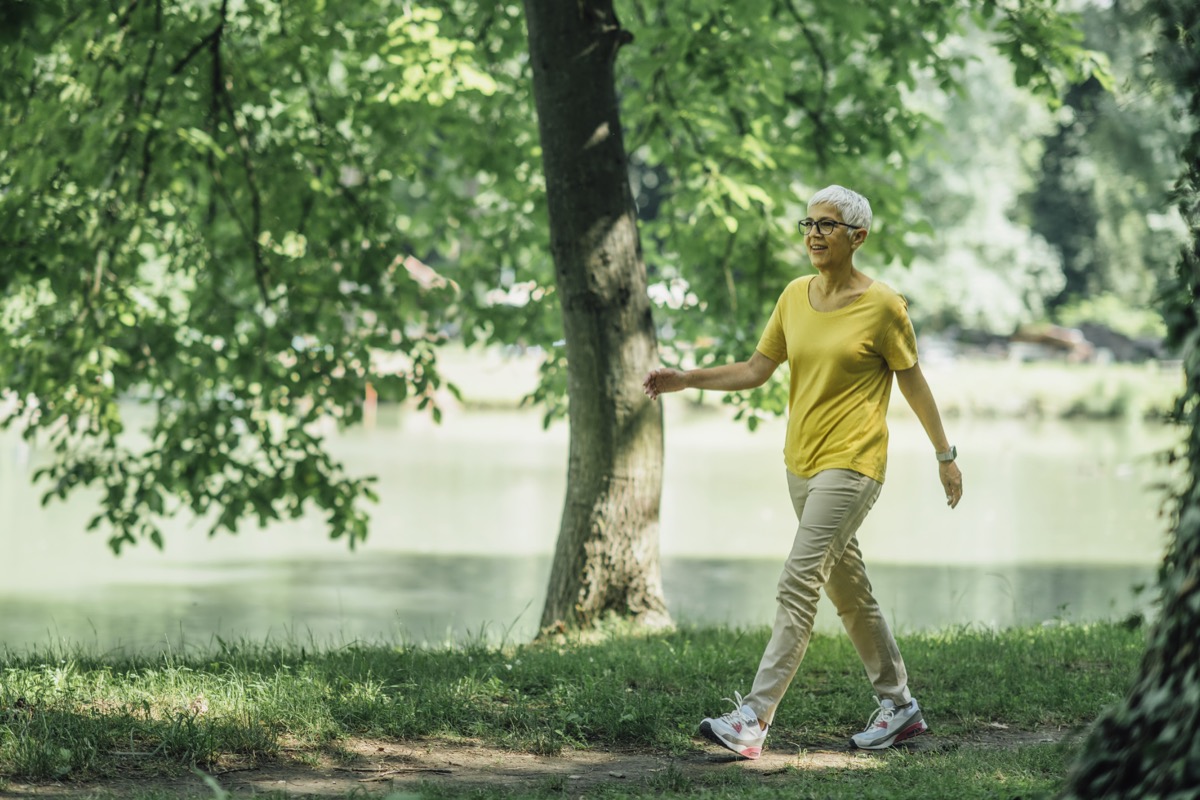For many, the possibility of developing dementia is one of the scarier aspects of aging. The condition affects 55 million people worldwide and is expected to grow to 78 by the year 2030, according to the World Health Organization (WHO). And while it’s common for people to look out for memory-related signs of dementia as they get older, a new study has found that the simple act of walking might be able to offer one of the earliest signs of its onset. Read on to see what could be a red flag for the neurological condition.
RELATED: If You Notice This While Talking, Get Checked for Dementia.


A September 2019 study published in the Alzheimer Association’s journal Alzheimer’s & Dementia set out to determine if there were a possible connection between a person’s gait while walking and the onset of either Lewy body disease (LBD) or Alzheimer’s disease. While both are forms of dementia, the latter is the most common and is typically categorized by memory issues, while the former is associated with movement problems such as stiffness or issues with balance.
To test their theory, researchers assembled 110 participants, made up of 45 people diagnosed with LBD, 36 diagnosed with Alzheimer’s, and 29 adults over 65 without either condition as a control group. Each participant was then asked to walk across a mat outfitted with sensors to measure everything about their walk, including their pace, the distance between each step, and the difference between how much time each foot spent on the ground.
Results showed that both groups of participants who had been diagnosed with dementia walked differently than those without the condition, showing shorter steps at a slower pace with each foot spending more time on the ground. However, there was even a difference between how Alzheimer’s and LBD walked, with those in the latter group showing even more changes in space and timing in their steps, Ríona McArdle, PhD, the study’s lead author and a post-doctoral researcher with the Brain and Movement Group at Newcastle University, wrote in The Conversation.


The researchers point out that the findings could prove to be helpful in spotting the disease in its earliest phases since most current methods, such as brain scans and memory tests, require more noticeable symptoms to be already present. McArdle cited other research that had found changes in gait related to dementia were likely to be one of the first signs of dementia to present itself.
Perhaps most importantly, the test could also give insight into which type of dementia patients are experiencing so they can be appropriately treated. “Providing patients with the correct diagnosis is especially important, as certain drugs, such as antipsychotics, can be harmful to people with dementia with Lewy bodies,” McArdle wrote.
For more health news sent right to your inbox, sign up for our daily newsletter.


Ultimately, the researchers concluded that the findings could have significant implications for improving the way we currently treat both LBD and Alzheimer’s disease, noting that more study on the topic is needed to better understand the connection between changes in walking and dementia.
“For people with dementia themselves, earlier diagnosis can give them and their families more time to understand their diagnosis and plan for the future,” McArdle wrote. “As of yet, there is no cure for dementia, but an accurate diagnosis gives access to support and information, and treatments to help alleviate symptoms.”


Other research has also found a connection between walking patterns and dementia. In a 2018 study published in the Journal of the American Geriatrics Society, a team of researchers from the University College London and University of Nottingham analyzed data collected from 3,932 adults older than 60 who had participated in the English Longitudinal Study of Aging. The team first recorded the participants’ walking speeds on two separate occasions sometime between 2002 and 2003 and again between 2004 and 2005. They then followed up by performing annual assessments with participants between 2006 and 2015 to see if any had been diagnosed with dementia.
The researchers then compared walking speed with results from the annual follow-ups and found an increase in dementia diagnoses among participants who clocked slower walking speeds. Results also showed that those who showed a more significant decrease in walking speed between the testing periods were even more likely to have ultimately been diagnosed with the degenerative disease.
Ultimately, the researchers concluded that both older adults with slower walking speeds and those who showed a decline in speed are at an increased risk for dementia. But the team stopped short of concluding that a decline in walking speed was responsible for a subsequent slowing of cognitive function in participants, saying that further research was needed to establish a connection between the two.
RELATED: If You’re Over 60, This Increases Your Dementia Risk by 55 Percent.